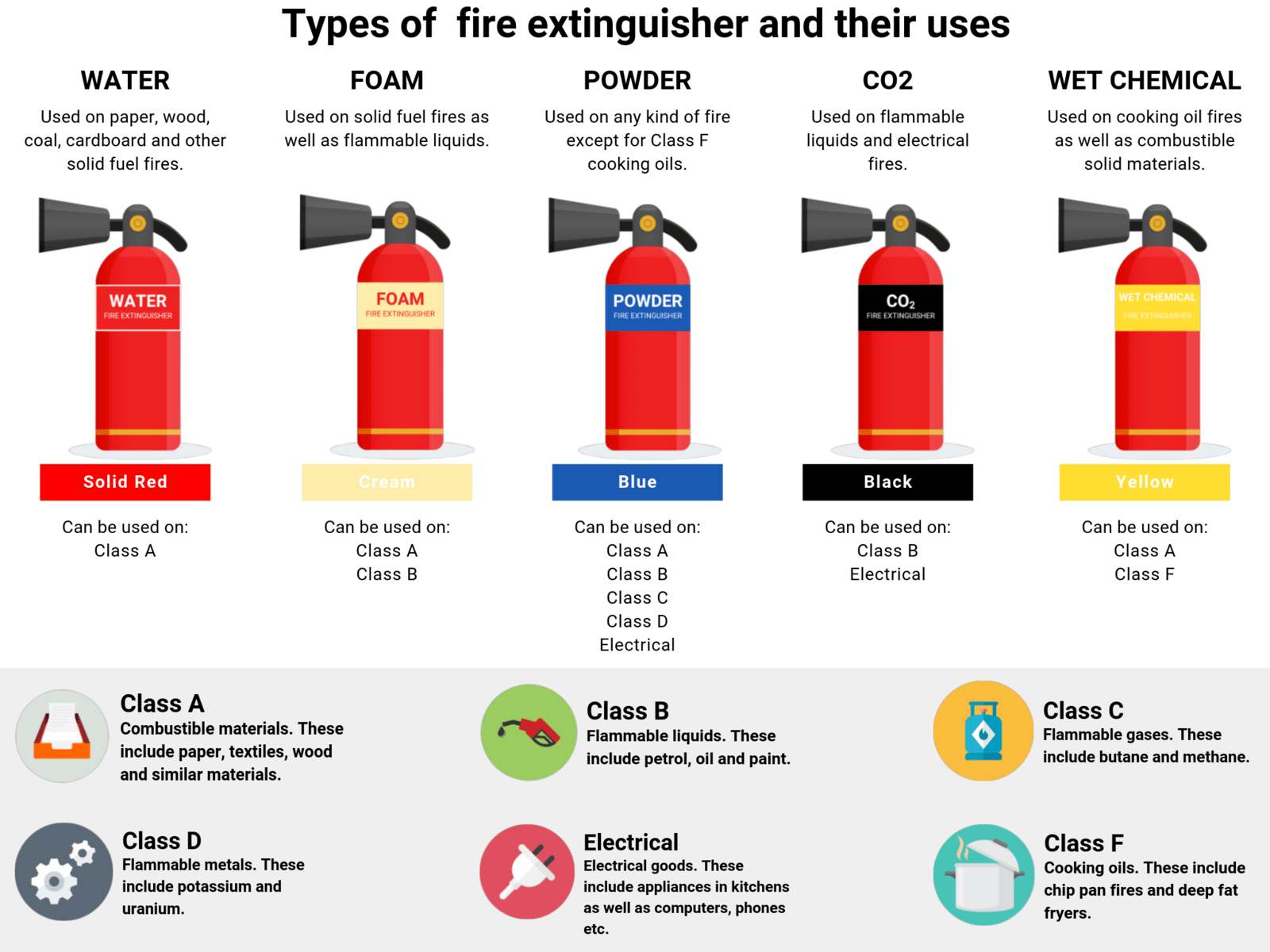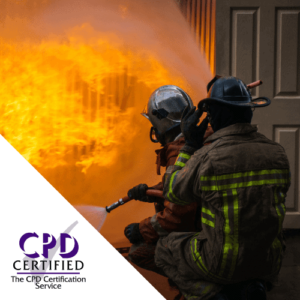In this article

Fire classification
Fires can be placed into different classes depending on what material is burning. This classification then gives us information on the type of fire extinguisher we should use to put out the flames.
Not all fires require the same type of extinguisher and the correct type has to be used for each blaze. Different fire extinguisher types are used to differentiate the best ones to use on the type of fire you are confronting.
Class A
Class A fires are burning flammable solids as fuel. Examples of these include paper and wood.
Extinguishers that can be used: Water, Foam, ABC Dry powder, Wet chemical
Class B
Class B fires are burning flammable liquids. Examples include petrol and paint.
Extinguishers that can be used: Foam, CO2 Gas, ABC Dry powder
Class C
Class C fires burn flammable gases. A couple of examples are propane and butane.
Extinguishers that can be used: ABC Dry powder
Class D
Class D fires are burning flammable metals. These may include lithium or magnesium.
Extinguishers that can be used: Dry Special Powder
Electrical
Any fire involving electrical equipment is classed as an electrical fire.
Extinguishers that can be used: CO2 Gas, ABC Dry powder
Class F
Class F fires are burning cooking oils or fat.
Extinguishers that can be used: Wet chemical
Water extinguishers
Water extinguishers are very common and should be used on solid materials only. This can include paper, wood or any other solid fuel.
Water based extinguishers are essentially filled with water and use compressed air to help this come out. Some will also have an additive that will help make them more effective. They work to cool the fire, removing heat from the fire triangle and will effectively stop any fire that has started.
Can be used on:
- Solid fuel fires
Not to be used on:
- Flammable liquids
- Flammable gases
- Flammable metal
- Electrical fires
- Cooking oil fires
Foam extinguishers
Foam extinguishers are used on burning liquids such as petrol or diesel fires. They can also be used on solid fuel fires in the same way as water extinguishers.
Foam fire extinguishers are actually water based (this is why they can be used on solid fuels) and have a cooling effect. They also contain ‘Aqueous Film Forming Foam’ which smothers the fire and seals in any flammable vapours. This will prevent the fire from reigniting and is why they are used to treat flammable liquids. Since fire only burns on top of flammable liquids, a foam extinguisher will create a barrier that smothers the flames.
Can be used on:
- Solid fuel fires
- Flammable liquids
Not to be used on:
- Flammable gases
- Flammable metal
- Electrical fires
- Cooking oil fires

CO2 extinguishers
CO2 extinguishers are typically used on electrical equipment. They can also be used to extinguish flammable liquids in the same way as foam extinguishers.
Since CO2 extinguishers are perfect for electrical fires, they are commonly found in offices or places where there is a lot of electrical devices. They work to replace the oxygen in the air with CO2 and will smother the fire in order to put it out. CO2 extinguishers are safe to be used on both high and low voltage electricals.
Can be used on:
- Flammable liquids
- Electrical fires
Not to be used on:
- Solid fuel fires
- Flammable gases
- Flammable metal
- Cooking oil fires
Dry Powder extinguishers
Dry Powder extinguishers can be used on most fire types including electrical devices. Dry Powder fire extinguishers are also known as ABC extinguishers because they can be used on fire types A, B and C. Specialist ABC extinguishers can also be used on flammable metals such as magnesium and titanium.
Powder extinguishers work to coat the fuel source and smother the fire. They will therefore stop any oxygen from getting to the fuel. Dry Powder extinguishers should not be used in confined spaces as particles that are released can be easily inhaled.
Can be used on:
- Solid fuel fires
- Flammable liquids
- Flammable gases
- Flammable metal
- Electrical fires
Not to be used on:
- Cooking oil fires
Wet Chemical Extinguishers
Wet Chemical extinguishers are specifically designed to be used on fires that have cooking oils and fats as their fuel. They can also be used on solid fuel fires but it is more common to use water or foam extinguishers for these.
This type of extinguisher uses a fine mist that cools flames as well as salts that form a layer on top of cooking oils. This type of extinguisher both cools and smothers the fire.
Can be used on:
- Solid fuel fires
- Cooking oil fires
Not to be used on:
- Flammable liquids
- Flammable gases
- Flammable metal
- Electrical fires

Share this infographic on your site

Fire Safety Awareness
Just £20
Study online and gain a full CPD certificate posted out to you the very next working day.















